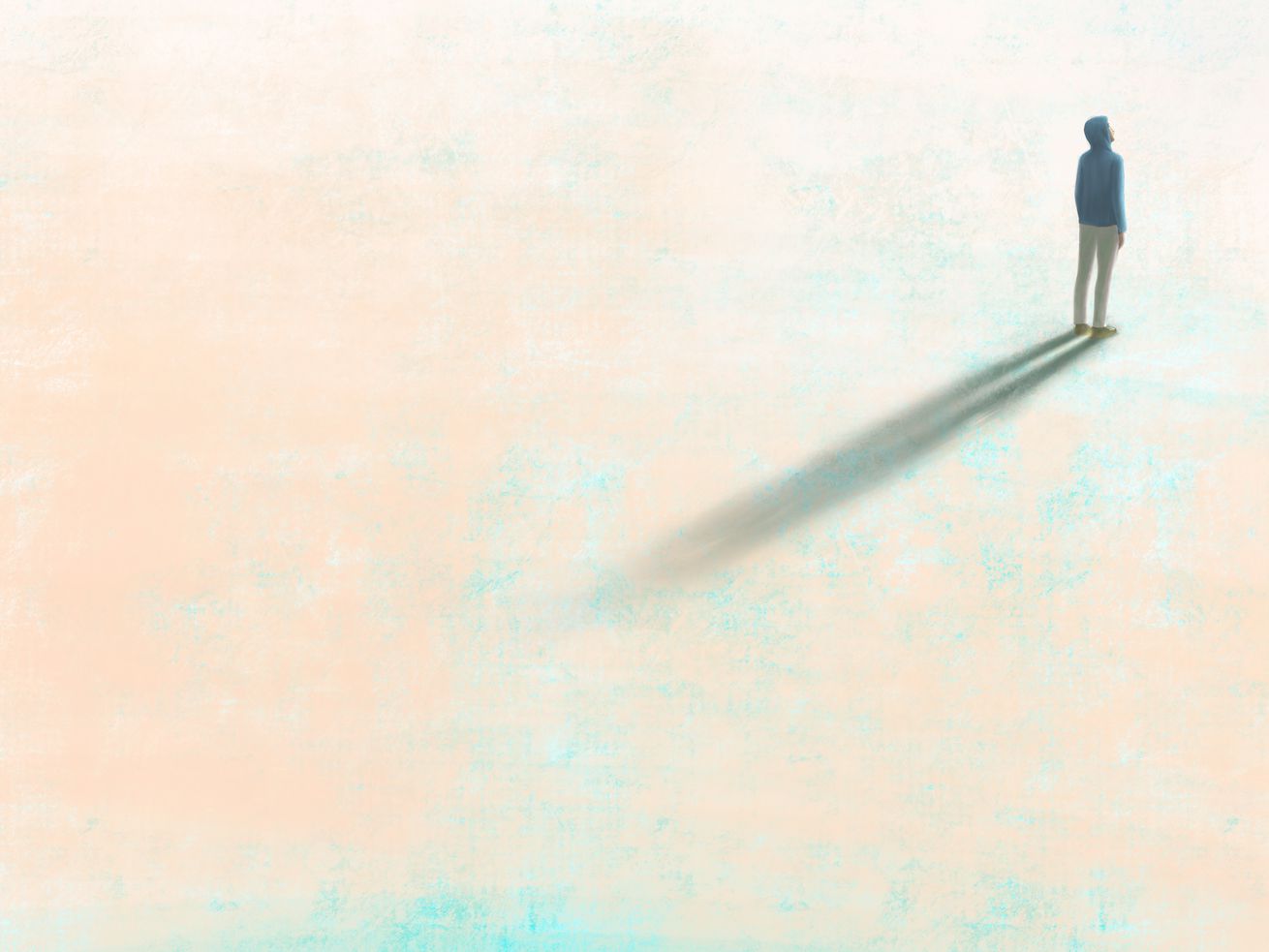
Getty Images/iStockphoto
Here’s how to interpret your own feelings.
Despite having a network of friends and acquaintances, Rohit Singla, an MD-PhD student in Vancouver, knows no other existence than one of loneliness. “I think I associate myself with being baseline lonely,” the 31-year-old says. Beneath the exterior of a productive, competent scholar is a man who feels he is lacking deep, caring, reciprocal relationships. Seeing friends in long-term relationships only illuminates the distance that naturally grows when romance takes precedence over friendship. When the group chat is silent in response to his attempts at coordinating a hangout, Singla suspects he’s low on his friends’ lists of priorities.
There are times he feels appreciated, less alone: when a pal checks in just to see how he’s doing or when someone he hasn’t spoken to in awhile reconnects. But despite these respites of connection, the undercurrent of alienation persists. “Loneliness,” Singla says, “is this simmering, ongoing feeling.”
Over the last decade, loneliness has reached so-called epidemic levels, with public health officials and researchers alike quantifying the mental and physical health impacts of living in social isolation. Still, there is no one way to experience loneliness. It’s the isolating dread of not having found your place in the world. It’s the heaving weight of grief after losing a person, a place, a community. It’s the pang of anxiety when you remember how long it’s been since you saw your best friend. It’s a sense of foreignness despite being surrounded by familiar faces. For Singla, loneliness is a palpable burden (“My loneliness physically feels heavy,” he says) as well as an emotionally destabilizing one. “It feels unsteady. I almost feel like I just lose myself.”
Researchers have put names to this kaleidoscope of experiences in the hope that by distinguishing the root causes of loneliness, people can better understand how to address it. “The differentiation of the nature of loneliness is predicated, to some degree, on the fact that you can intervene and do something about it,” says Christina Victor, a professor of gerontology and public health at Brunel University London.
What is loneliness?
The state of isolation is not the same as loneliness. “People can still feel lonely when they’re around other people,” says Julianne Holt-Lunstad, a professor of psychology and neuroscience at Brigham Young University, ”and you can be isolated but not feel lonely.” Loneliness refers to the distressing feeling you have when your social desires don’t align with your reality. Someone may have a close confidant in their romantic partner but still feel lacking in social connection. Someone else could interact with people all day but crave deep conversation. Loneliness is a personal experience, Victor says, not an objective one. An outsider cannot diagnose a person as being lonely; only that person can admit loneliness to themselves and others.
Just like hunger or thirst, loneliness is a biological signal prompting people to satiate their need for social interaction, Holt-Lunstad says.
Within the overall scope of loneliness are distinct ways people can experience it. According to Chikako Ozawa-de Silva, a professor of Japanese studies and anthropology at Emory University, the breakdown is as simple as “ordinary” loneliness (sadness after a breakup or a move, homesickness), grief, and “afflictive” loneliness. The latter “is a deep, pervasive sense of disconnection,” says Ozawa-de Silva, who is the author of The Anatomy of Loneliness: Suicide, Social Connection, and the Search for Relational Meaning in Contemporary Japan. “Of not being accepted or acknowledged by others.” Victor distinguishes between transient loneliness — a period of heartache that comes and goes — and chronic loneliness.
Three common types of loneliness have been defined in the scientific literature, Victor and her colleagues found in a 2021 review of loneliness studies dating back to 1945. There, the experiences of loneliness fell into three categories: social, emotional, and existential. To be socially lonely is to lack social connection with those you know and love, Victor says. If you’re grieving the loss of a person, you’re experiencing emotional loneliness. Those who feel separated from others due to death, divorce, or physical or mental decline are said to endure existential loneliness. The lived experience of loneliness is less about feeling one of these three ways and more a Venn diagram of intersecting and overlapping social desires: a yearning for another community outside of the ones you already inhabit, desiring the intimate connection offered by a romantic partner.
Louise Hawkley, a principal research scientist at NORC, a nonpartisan research organization at the University of Chicago, isn’t totally satisfied with those descriptors. “Social loneliness, it’s also emotional,” she says. In her research, Hawkley focused on areas of connectedness that contribute to loneliness: intimate connectedness (deep relationships with, say, a spouse); relational connectedness (quantity of friends and how often you see them); and collective connectedness (feeling like you’re a part of a community). Like other frameworks of loneliness, these dimensions of connectedness are not independent of one another; people need to connect in all three domains in order to feel emotionally fulfilled. “We think of those three dimensions as critical that underlie loneliness,” Hawkley says. “People who tend to feel lonely on one of those dimensions tend to feel lonely [overall].”
While the signifiers may slightly differ, the experiences they describe are universal. The phrases “feeling alone in a crowd,” “lost at sea,” and “living in darkness” conjure vivid images for social, emotional, and existential loneliness or the lack of intimate, relational, and collective connectedness.
Experiences of loneliness change as life shifts
Loneliness takes different forms throughout a person’s lifespan. A child, for instance, can feel socially ostracized by their peers. Young adulthood can be alienating for teens who leave home for college. New parents often feel untethered from their communities, especially among childfree friends. Come retirement, relationships with colleagues can be strained without physical proximity. “People who are lonely because they’ve geographically relocated,” Hawkley says, “are going to feel something different than somebody who’s lonely because their spouse just died, or somebody who feels lonely because they’ve become immobile and they’re limited to staying in their house.”
For much of her career, loneliness was only thought to impact older people, Victor says. But young adults can feel social, emotional, and existential loneliness. “I hypothesize that one of the reasons that we see high levels of loneliness in young people is there probably is social loneliness: ‘People in my gang won’t talk to me anymore,’” she says. “There is the emotional loneliness of perhaps as a young person, losing your grandparent who might have been a very important part of your social group … And I’m quite taken with the idea that perhaps some of the loneliness that young adults experience is this existential bit, particularly if you think about the challenges confronting young people in terms of climate change and war.”
A more contemporary contributing factor, social media, shapes our expectations of relationships. Consuming the highlight reel of peers’ social lives fosters comparison among younger cohorts. Perhaps ironically, young people who spend more time on social media as a means of maintaining relationships feel lonelier than those who have differing motivations for using social media, according to a recent study. “Are we using it to supplement our friendship experience,” asks friendship coach Danielle Bayard Jackson, author of the forthcoming book Fighting for Our Friendships, “or are we using it to take the place of being with people?”
Social, health, and economic factors also make a person more prone to loneliness. Young adults under the age of 30 and those who make less than $24,000 per year report higher levels of loneliness compared to older and wealthier people, according to the Gallup National Health and Well-Being Index. Hispanic and Black Americans, parents, and those with physical or mental health challenges are also more likely to be lonely, according to a 2021 survey by Cigna and Morning Consult. “I wonder if that’s just a [lack of] group connectedness — the collective — because they’re often a peripheralized population,” Hawkley says. “They’re not made to feel like they belong. The same would be true [of] LGBTQ folks — [they] are definitely at a higher risk, immigrants at a higher risk.” Fostering meaningful connections can prove challenging when you’re working three jobs or don’t feel welcome in a community.
Just like hunger or thirst, loneliness is a biological signal prompting people to satiate their need for social interaction
Multiple cross-country moves gave Emily Gonzales, 35, more clarity when it came to her own social needs. Upon relocating to Indianapolis, where she had grown up, she noticed a wedge between herself and her childhood friends. Their values didn’t align, she realized, and they didn’t have similar aspirations. “You’re around a bunch of people, but you don’t feel like anybody really gets you,” says Gonzales, who works in medical sales. “These people I’ve known for my entire life, but I don’t feel like they know me or I know them.”
Once Gonzales and her husband moved to their current home base of Scottsdale, Arizona, she was purposeful when forging new connections. She used Bumble For Friends to spend time with people with similar interests and life experiences, like being a stepmom. One of the first women she met was Ashlee Smith, a 36-year-old insurance broker who had also recently moved to the area from Portland, Maine.
Though Smith recently had a baby, she and Gonzales still make time for one another. Gonzales frequently checks in with Smith and even traveled with her and her infant to Portland. “Your world gets so much smaller,” Smith says of parenthood. “Emily and I even had a conversation about it because she could tell I was just a little off. So she checked in and she’s like, ‘What do you need? How can I help you?’”
How to address various dimensions of loneliness
Understanding the drivers of loneliness can help individuals — and societies — effectively resolve it. Because each dimension of loneliness and connection requires different solutions, one blanket suggestion may not work for every lonely individual. “Simply increasing social contact may not reduce someone’s loneliness,” Holt-Lunstad says.
Self-reflection can offer a few solutions. In one of her studies, Victor found 71 percent of older adults had felt lonely during their lives. She and her collaborators asked participants how they had addressed past loneliness. “People were referring to things that they did. One I really liked, but we’ve never published it,” she says. “A guy said, ‘If I feel lonely, I’d go to the church or the pub, depending upon what day of the week it is.’” To manage present loneliness, remember past bouts of alienation and mull over what made you feel more connected. Can you replicate the strategy in your current situation?
If you feel like you’re lacking a community, joining the first club that comes to mind may not be inherently satisfying. Instead, consider important aspects of your identity you’d like to explore, suggests Bayard Jackson. Complete the phrase “I am …” to help guide you. “I might say, ‘I am Black. I am a woman. I am a Christian. I am a mom,’” she says. “Then ask yourself for each one of these identifiers, ‘Am I in community for each one of these in spaces that are formed by this aspect of identity?’” If not, you might want to seek out connection with people who share one of these domains.
You don’t need to accomplish the modern feat of making new friends in adulthood to combat loneliness either. Deepening existing relationships is just as rewarding, but it also requires a shift in mindset: Strengthening these friendships must be a priority. Diversifying your social diet to include interactions with strangers and acquaintances is also socially fulfilling. “We often have to make time out of our busy schedules to be physically active,” Holt-Lunstad says, “and we need to make time in our busy schedules to be socially active.” Both Gonzales and Smith say they were strategic in identifying the types of people and friendships that would satiate their loneliness.
Connection can also be found absent other people. People form strong relationships to places (like a hometown or a hiking trail) and activities (like music or art), Ozawa-de Silva notes. Visiting these locales or engaging in these hobbies may curb loneliness.
But the responsibility to address loneliness can’t fall solely to the individual. Societies that value productivity and competition over the unique merits of its people breed loneliness, says Ozawa-de Silva. “An increasing number of individuals who are experiencing loneliness, anxiety, panic [disorders],” she says, “I think that’s a sign that something is really not right in our society.” To help address this crisis, Ozawa-de Silva says communities can instill values like compassion and empathy at an early age and encourage a teamwork-oriented goal structure for children. “We need to address it at the systemic level,” she says. “Maybe social education, different kinds of programs, something that would hopefully change a few priorities in contemporary societies to think about the limitations of hypervigilance and a hyperfocus on competition and productivity.”
Addressing any form of loneliness isn’t an overnight endeavor. Relationships of every variety require dedication and persistence to bloom. Consider your quest toward social harmony like tending to a garden, planting seeds for a variety of different types of connection — intimate, relational, and collective alike.
——————————————-
By: Allie Volpe
Title: There’s more than one way to feel lonely
Sourced From: www.vox.com/even-better/24006316/feeling-lonely-social-emotional-existential-loneliness-epidemic
Published Date: Tue, 02 Jan 2024 11:00:00 +0000
I'm a writer for lifestyle publications, and when I'm not crafting stories, you'll find me cherishing moments with my family, including my lovely daughter. My heart also belongs to my pets—Sushi, Snowy, Belle, and Pepper. Besides writing, I enjoy watching movies and exploring new places through travel.

